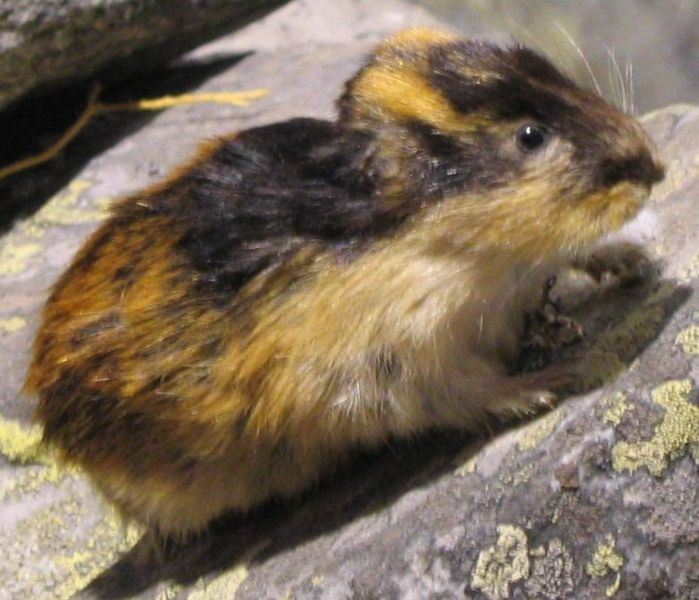Falling Lemming Populations
Interview with
Chris - Lemmings now, and although these animals don't really throw themselves off precipices, in recent years, their population cycles have nosedived. The reason, discovered by ecologist Nils Christian Stenseth, is one that British train companies would be proud of. It's down to climate change causing - you've guessed it - the wrong sort of snow.
Nils - A lemming is a small rodent and the Norwegian lemming is a very charismatic one, yellow and black. It used to be that every 3 to 4 years, there were massive numbers of lemmings in the mountains then the next year it was gone. That is what we referred to as the lemming cycle. And the lemming cycle occurs for lemmings as well as for many other small rodent species, and the lemming cycle was a characteristic feature. There are many stories written about this. A translation of the bible to the Nordic languages, the swarms of grasshoppers in the middle east, there was a footnote by the translator saying that this is like lemming cycles. So, it's a well-known phenomenon. Since the mid '90s, there have been no regular lemming cycles.
Chris - Well, they just stopped, just vanished.
Nils - They had vanished and that is well-known.
Chris - But the lemmings are still there.
Nils - Lemmings are still there, but the massive occurrence at the regular time periods disappeared. So that has been an interesting thing to try to find out why. We did work doing statistical time series analysis, where we looked at the dynamic structure of the lemming population and how that was affected by climate, temperature and precipitation and the like. What we found was that the kind of snow that was falling was a critical determinant on whether it was going to be a regular cyclic phenomenon or not. It used to be that when snow came in this part of the world, it was cold so it came as dry and soft, so that a small space between the ground and the snow could build up. And within that space, lemmings could survive very well and they reproduced and built up a population that was high in the spring and couldn't continue to be high if it didn't crash during the summer.
climate, temperature and precipitation and the like. What we found was that the kind of snow that was falling was a critical determinant on whether it was going to be a regular cyclic phenomenon or not. It used to be that when snow came in this part of the world, it was cold so it came as dry and soft, so that a small space between the ground and the snow could build up. And within that space, lemmings could survive very well and they reproduced and built up a population that was high in the spring and couldn't continue to be high if it didn't crash during the summer.
Chris - Why would their population have this 4-year cycle because the snow is going to come every year? So, why does their population grow and then suddenly plummet?
Nils - When they crash, they crash to very low densities and they crash most likely because of the predator population building up. So they crash to very low levels and it takes time for them to build up. And to build up very high densities, they need a period that they are free from heavy predation and that's what they get during the snow, during the winter period, and it takes 3 to 4 years to build up such a population. But in the mid '90s, all this was gone and what we found in this paper published in Nature was that the snow had changed also from being soft and dry to wet. Hence, the lemmings could not build up. One year ago, I predicted that there would be a lemming peak all over Norway, as a matter of fact, all over Scandinavia because the previous year had been very cold, very good snow conditions and we were then in a middle of a good winter. And true enough, there was a lemming peak last year all over Norway.
Chris - So, are you seeing a return to nice cold winters again or is the snow still unreliable and soft and wet?
Nils - Well, I'm not a climatologist. I think that there were two good winters for lemmings. Climatologists tell us that won't be as regular a phenomenon as it used to be. So, I think the lemming cycle has not come back. I think the lemming cycle has gone, but you will occasionally have high years with lots of lemmings, but it won't be regular.
Chris - What's that done to the predators and from an ecological point of view, what are the onward consequences? Is this just sort of a mathematical phenomenon that if the conditions come right again, it will re-establish or are they going to be onward impacts which are irreversible?
Nils - I think the lemming cycle will come back if the climate changes, but it might take quite a bit of time for the whole ecosystem to recover because when the lemmings are gone, that affects the ptarmigan because when predators have no lemmings to eat then they'll go to other species including ptarmigan. It also affects the interaction between the Arctic fox and the red fox. The red fox being competitively superior to the Arctic fox. Unless there are lots of lemmings, then the Arctic fox does well. So it will change the whole ecosystem. So maybe the Arctic fox will go extinct on the mainland and only survive on the small part of Spitsbergen in the Norwegian territories.










Comments
Add a comment